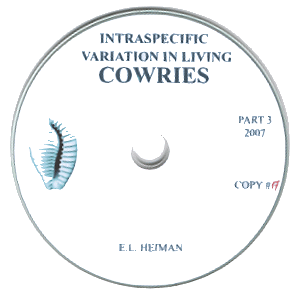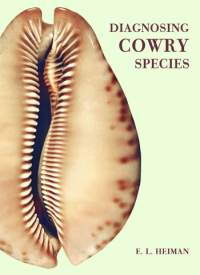As articles are received from Ed and formated, they will be linked up toASAP.
Thanks for your patience: Avril Bourquin
|
Ed Heiman's Personal Malacology Page "VARIABILITY OF COWRY POPULATIONS" |
|
| Ed's Contact Information: | E.
L. Heiman P.O.Box 664 Rehovot 76100, Israel E-mail: heimel@netvision.net.il |
|
by Ed Heiman |
|
|
|
This MANUAL contains the main diagnostic shell characters of 189 species and the main diagnostic shell characteristics of 83 subspecies, the taxonomic level of which is confirmed in a Project "Intraspecific variation in living cowries" (1998-2012). All conclusions drawn in the Project are based on results of conchological studies.
The main definitions and criteria of the conchological method used and the procedure of its application are explained in detail; they can be repeated by others. A lot of information
useful for diagnosing taxa of Cypraeidae is given. |
|
Living
Cowry Species
by Ed Heiman |
|
"List of living cowry species 2007" is currently available
as a pdf file. A project "Intraspecific variation in living cowries"
was initiated in 1997 in order to check the taxonomic identity of the
second (problematical to me) group of taxa. In this conchological project,
the definitions of species and subspecies and other criteria were first
accepted (these definitions are very shortly mentioned also in a text
preceding the list) and after that available representative samples
of shells of hundreds of taxa were tested. There are taxa, shells of which are rare and not available for study; the true locality of certain other taxa is not clear; there are limitations of conchological methods and other confusing factors hence this is not the final list; final lists is an illusion. |
|
Ed's
Miscellaneous Cowry Articles and Supplements
|
||
|
TRITON
24 SUPPLIMENT ( pdf files):
September, 2011 |
||
| 2. Heiman E. L. | Recent Cypraeidae: A Preliminary List of taxa not recognized as valid in the project "Intraspecific Variation in Living Cowries" Version (09.2011). Suppliment 2 to Triton (pdf file). | |
|
|
||
| 1. Heiman, E.L. |
CRIBRARIA FISCHERI VAYSSIER, 1910, A SYNONYM OF CRIBRARIA CRIBRARIA (LINNAEUS, 1758): ITS NOMECLATURAL HISTORY AND A COMPARATIVE STUDY OF SHELL CHARACTERISTICS |
35
Link |
| 2. Heiman, E.L. |
CRIBRARULA GASKOINI (REEVE, 1846): AN INTERESTING FORM, WHICH CAN PERHAPS BE TREATED AS A SUBSPECIES OF C. CRIBBRARIA (LINNAEUS, 1758) |
35
Link |
| TRITON No 19 March 2009 | ||
|
Supplement 1: A
STUDY OF INTRASPECIFIC VARIATION IN PUSTULARIA CICERCULA
|
||
|
Supplement 2: A
TAXONOMIC HISTORY OF AND INTRASPECIFIC VARIATION
|
||
|
Supplement 3: CONCHOLOGICAL
INFORMATION PUBLISHED IN TRITON 1-19
|
||
|
Supplement 4: CONCHOLOGICAL
INFORMATION PUBLISHED IN TRITON 1-19
|
||
| Supplement 5:
CONCHOLOGICAL INFORMATION PUBLISHED IN TRITON 1-19 (2000 THROUGH 2009) |
||
|
Supplement 6: CONCHOLOGICAL
INFORMATION PUBLISHED IN TRITON 1-19 |
||
|
Miscellaneous articles
|
||
| 14 NEW PINK FORM OF EROSARIA TURDUS PARDALINA (March 2008) | ||
| 15. A HYPOTHESIS: MARGARITA–A
SMOOTH FORM OF PUSTULARIA CICERCULA (March 2008) |
||
| 16. REFLECTIONS UPON PUSTULARIA MAUIENSIS AND RELATED TAXA (March 2008) | ||
| 17. PUSTULARIA
CHIAPPONII SEEMS TO BE A FORM OF P. BISTRINOTATA (March 2008) |
||
| 18. ABOUT THE SUBSPECIES CRIBRARULA CRIBRARIA ESONTROPIA (March 2008) | ||
| ABOUT OVATIPSA COLOBA (March 2007) | ||
| ABNORMALITIES IN COWRIES: ROSTRATED SHELLS OF EROSARIA NEBRITES (MELVILL, 1888) |
||
| ABNORMALITIES IN COWRIES: Over callused and Rostrated Shells (October 2005) |
||
| SHELLS
OF EAST SINAI, AN ILLUSTRATED LIST. CYPRAEIDAE (October 2005) by E. L. Heiman & H.K. Mienis |
||
| REFLECTION UPON A SCIENTIFIC METHOD | ||
| NEW CONCHOLOGICAL INFORMATION
ON BLASICRURA TERES-LIKE SHELLS OF THE HAWAIIAN WATERS (October 2005) |
||
| 1. TWO POPULATIONS FROM THE CARNEOLA COMPLEX IN THE SINAI AREA OF THE GULF OF AQABA |
| 2. EROSARIA EROSA (LINNAEUS,1758) FROM NEW SOUTH WALES, AUSTRALIA |
| 3. LYNCINA ARGUS (LINNAEUS,1758) |
| 4. USE OF VARIETAL NAMES |
| 5. ABOUT ERRONEA CAURICA (LINNAEUS, 1758) FROM AMERICAN SAMOA AND "CAURICA CORROSA" |
| 6. TWO POPULATIONS OF CYPRAEA PANTHERINA |
| 7. FLAT AND CONVEX FORMS IN THE ARABICA COMPLEX |
| 8. A ROSTRATED FORM OF EROSARIA TURDUS PARDALINA (DUNKER, 1852) |
| 9. LYNCINA LYNX (L., 1758) FROM THE EAST COAST OF SINAI |
| 10. COWRIES WITH DARK MARGINS ("NIGROCINCTA") |
| 11. BISTOLIDA ERYTHRAEENSIS (SOWERBY, 1837) IN THE SINAI AREA OFTHE GULF OF AQABA AND ITS COMPARISONWITH B. STOLIDA (L., 1758) |
| 12. PURPURADUSTA GRACILIS (GASKOIN, 1848) FROM SINAI COAST |
| 13. ON THE IDENTITY OF PURPURADUSTA MICRODON (GRAY, 1828) IN THE SINAI AREA OF THE GULF OF AQABA |
| 14. A LONG TOOTHED FORM OF EROSARIA EROSA (L., 1758) |
| 15. ABOUT EROSARIA NUCLEUS STURANYI IN THE GULF OF AQABA |
| 16. "About the Teres Complex": (published in the journal of the Israel Malacological Society TRITON #4 in September 2001.) |
| 17.
Leproicypraea Mappa: Teeth Color as a Shell Characteristic: (published
in the journal of the Israel Malacological Society TRITON
#4 in September 2001.) |
| 18. Erosaria Nedbrites Form Labrospinosa: (published in the journal of the Israel Malacological Society TRITON #8 in September 2003.) |
| 19. |
20. PALMADUSTA LENTIGINOSA (GRAY, 1825) (published in the journal of the Israel Malacological Society TRITON #9 in March 2004.) |
|
21. Intraspecific
Variation in Erosaria Lamarckii (GRAY, 1825) |
| 22. |
| 23. SCHILDERIA ACHATIDEA (SOWERBY, 1837) |
| 24. LURIA LURIDA (LINNAEUS, 1758) |
| 25. ERRONEA WALKERI (SOWERBY, 1832) |
| 26. PALMADUSTA FIMBRIATA (GMELIN, 1791) |
| 27. EROSARIA MILIARIS (GMELIN, 1791) |
| 28. PALMADUSTA CLANDESTINA (LINNAEUS, 1767) |
| 29. ERRONEA OVUM (GMELIN, 1791) |
|
Now
available as an electronic book in the pdf format on a CD ROM
|
| A report , which
is the result of a statistical study using more than 10,000 cowry shells
is now available as an electronic book in the pdf format on a CD ROM.
The studied groups of populations are known in the literature as species
or subspecies but their taxonomic identity is often questioned. The statistical
study is an attempt to elucidate this problem using conchological methods.
Two main criteria are established for recognizing subspecies and all the groups of populations are critically examined according to these criteria: first, subspecies must be geographically separated population groups of the species; second, the majority (70% or more) of shells of the subspecies must differ by at least one diagnosable shell characteristic (the main diagnostic shell characteristic) from the other subspecies of that particular species. Statistical shell characteristics are calculated for 143 taxa. The specific rank of 36 cowry population groups is confirmed, 15 of which are turned out to be monotypic species. The subspecific rank of 69 cowry population groups is confirmed and the remaining 74 are treated as synonyms, as taxa which are not separable conchologically, or taxa which need more conchological material and further study to re-examine their taxonomic level.The main diagnostic shell characteristics, which can be used for distinguishing between the recognized taxa, are given for all subspecies. Numerous formae
found in the studied conchological material are listed and illustrated
in approximately 900 pictures. |
|
Book
Review
|
|
EVOLUTION, THE TRIUMPH OF AN IDEA Carl Zimmer, 2002. Published by W. Heinemann, London. 364 pp. |
|
New
CD 2008
|
|
 |
ABSTRACT This Report-3 contains the results of a statistical study, which is the third part of the project “Intraspecific variation in living cowries.” The groups of cowry populations studied are known in the literature as species or subspecies but their taxonomic identity is often questioned and there is no consensus among malacologists regarding their true taxonomic identity. The current study is an attempt to elucidate this problem using statistical conchological methods.
In this third part of the project, as in the reports covering the first and second stages of the project, two main criteria are used for recognizing subspecies and all the samples of shells representing different groups of cowry populations are critically examined according to these criteria: |
|
-First, subspecies are geographically separated population groups of the species. -Second, the majority (70% or more) of shells of the subspecies must differ by at least one diagnosable shell characteristic (the main diagnostic shell characteristic) from the other subspecies of that particular species.
Conchological characteristics used consist of two types: quantitative characteristics—the average shell length, relative width and height, and normalized teeth count—and qualitative characteristics—the percentage of shells with a definite quality such as the shell color, pattern, and shape or shell profile etc. Groups of cowry populations, which stand the check, are recognized as valid subspecies.
This study evaluates 25 taxa, which have been described as species or subspecies by other authors, using 1259 shells. Of this number I have been able to confirm 6 monotypic species. The remaining taxa are either treated as synonyms or as taxa, which are not separable conchologically or needs future study. The latter groups are taxa for which the main diagnostic shell characteristics are not yet determined or I could not obtain sufficient material to determine their limits satisfactorily and thus a further study is required in order to establish their correct taxonomic rank. The main diagnostic shell characters are given for all recognized species. The shells characters studied and forms found among the conchological material studied, are listed and illustrated through numerous pictures. This Report-3 2007 is in fact an electronic book.
I am sorry that my conclusion may disappoint those collectors who like uncommon and interesting South African cowries, but these are the facts and my conclusions. According to long standing conchological practices, shells of any cowry subspecies should differ from shells of other subspecies of the same species by at least one substantial diagnostic characteristic. It is the responsibility of the author of a new subspecies to prove the existence of a separate population, to choose the appropriate diagnostic characters, and to prove the subspecific level of the population under study. It certainly should not be left for consequent authors to prove the opposite. |
|
|
For Purchasing
Information Contact: E. L. Heiman |
|
|
New
Book 2004
|
|
 |
I
am glad to inform you about publication of my book "Diagnosing
cowry species."
This book is designed to be an easy-to-use manual that enables malacologists and shell collectors to identify cowries using shell characters only. Shell characters of 268 cowry taxa, which have been described as extant species, are compared. A criterion is established and all the 268 taxa are critically examined according to this criterion: each cowry species must be distinguished from other species of Cypraeidae by at least one well-recognizable shell character—Main Diagnostic Shell Character (MDSC)—that shows no intermediate stages |
|
Following the above criterion it was possible to diagnose 211 cowry species, 14 subspecies and 19 synonyms. The remaining 24 taxa refer either to rare shells not available for study or to populations, the descriptive shell characters of which are not yet established. These taxa should be re-examined in order to come to satisfactory conclusion as to their status i.e. species, subspecies or synonym. To allow for easy comparison, color illustrations and the main diagnostic characters for shells of the defineable taxa that are similar to each other are given on the same page. Additional information which may provide extra clues for distinguishing between species of similar appearence includes: notes to supplement the main diagnostic characters; discussion of several groups of cowry taxa, which are especially difficult to tell apart; a list of genera in Cypraeidae and the distribution range of taxa with similar shells.
|
|
|
Purchasing Information: E. L. Heiman |
|
|
Man
and Mollusc Search Engine
|
|
This is a new counter system set up by Globel on December 01, 2002 |
